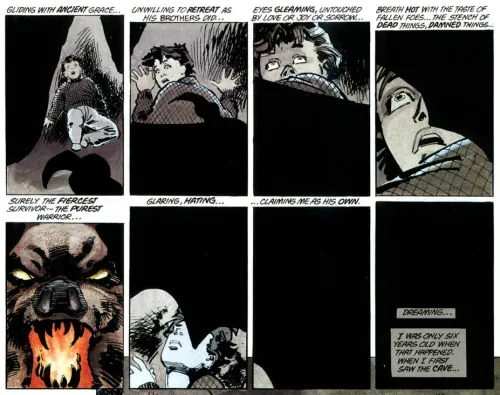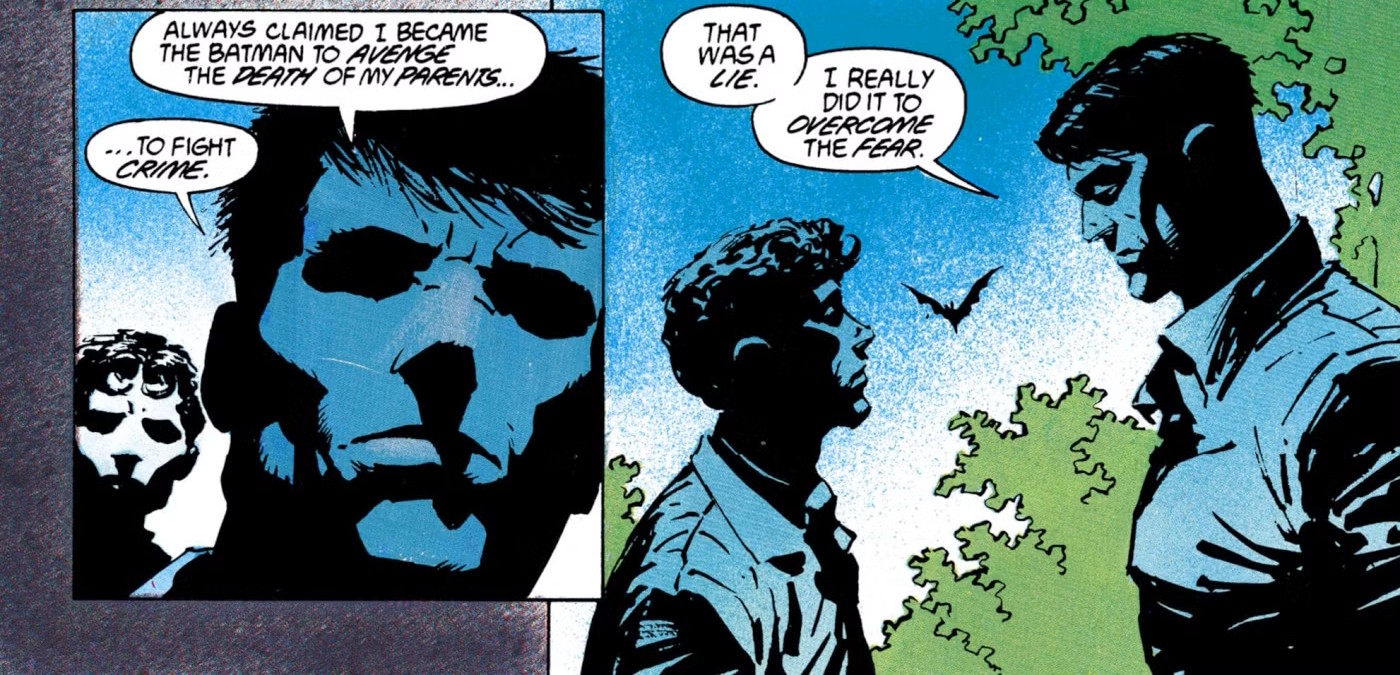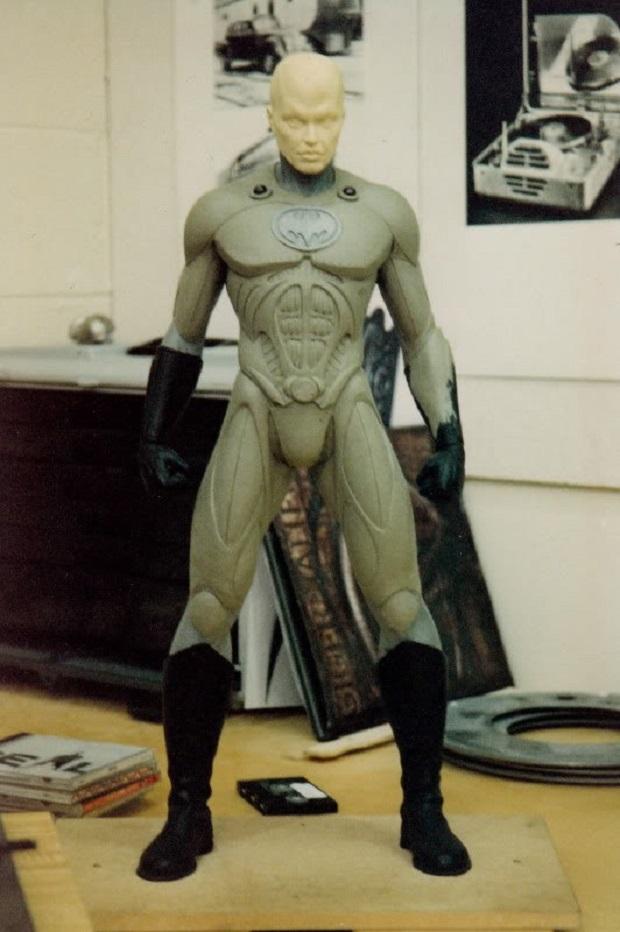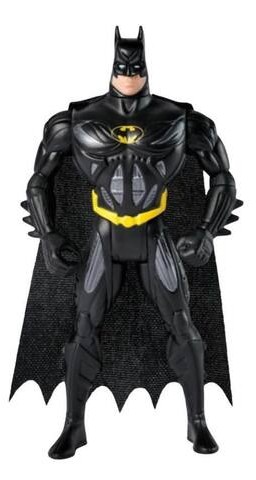WHAT IS BATMAN 3?
The Batman 3 audio drama is an adaptation I wrote of the scripts for Batman Forever, written by Lee and Janet Scott Batchler, with additions by Akiva Goldsman.
With an adaptation like this, you’re only as good as your source material and the source material here is one of my favorite Batman scripts.
I hesitate to even say I “wrote” this because “writing” this was really more of a fun fanboy game of “pick and choose” across the three drafts of Batman Forever I had: a draft written by the Batchlers before Goldsman came in, an updated draft with Goldsman’s rewrites, and the shooting script that was close to what was shot for the film. I cross referenced all three and picked what elements I thought worked best.
In the Batchlers script, lines are phrased or done in a different way and plot points play out differently from before. These would all add to an experience that hopefully feel like an alternate version of the movie playing out in your head.
Still, a version of Akiva Goldsman’s draft had to also be in here as his additions play a big part in why there’s the fan movement to release the extended “Schumacher Cut” of the film.
It was Goldsman who added the “red book” subplot, the diary entry that sent a young, guilt ridden Bruce Wayne running from his parents’ funeral and falling into the cave, as well as the big revelation when he rereads his father’s journal as an adult.
I added that element as well as other dialogue if I thought his was the best version, such as the conversation where Bruce tries to talk Dick out of taking down the path of revenge.
Hence, the credits were presented the way they were, as “written by the Batchlers with additions by Akiva Goldsman.”
The Batchlers’ draft: https://ia600107.us.archive.org/21/items/Batman3ScriptProductionDraftAkivaGoldsman/Batman%203%20script%20Early%20Draft%20The%20Batchlers.pdf
The Goldsman draft: https://ia800107.us.archive.org/21/items/Batman3ScriptProductionDraftAkivaGoldsman/Batman%203%20script%20Production%20Draft%20Akiva%20Goldsman.pdf
The shooting script (big thanks to Superhero Stuff You Should Know follower Mindd Kidzag for sharing):
https://x.com/MinddKidzag/status/1802483319780548690
THE HISTORY OF BATMAN FOREVER
What if Tim Burton had directed Batman Forever? If you know my podcast Superhero Stuff You Should Know, you know this is a complicated question.
Despite online misconceptions, the story of Batman Forever, with Batman and Robin vs. Two-Face and Riddler, was developed by Joel Schumacher and the Batchlers, whom I interviewed for Superhero Stuff You Should Know.
As the Batchlers shared with us, Tim Burton only supervised the passing of the torch from him to Schumacher and hired them as the screenwriters for Joel (hence, his producer credit on the film). Schumacher and the Batchlers then developed the script together, under the title we’ve used here: Batman 3 (not Batman Continues, as the fanmade rumors suggested).
The ideas of using Two-Face, Riddler, and Robin came from the collaboration with Schumacher, as well as the creation of Chase.
The concept that Tim Burton had wanted to do the Batman Forever story with his own cast is simply not true.
Of course, making a fanmade audio drama called Tim Burton’s Batman 3 with the story of Batman Forever just makes it even more complicated! But the truth is, we wanted to bring the idea of a Burton Batman Forever to life.
Naturally, that would mean bringing in the Danny Elfman theme, which was only used in the trailers for the film.
It would mean Billy Dee Williams would continue as Harvey Dent after playing him in the 1989 film and play Two-Face.
It would also mean Marlon Wayans, who was hired to play Robin in Batman Returns before getting cut, would play the Boy Wonder here.
And it’d obviously mean Michael Keaton would be Batman.
To add further complication to this, Schumacher had originally wanted Keaton to return and the script by the Batchlers was written with Keaton in mind.
Keaton’s claims over the years have been that he walked away due to disliking the script and Schumacher’s direction, but when looking at the original drafts, this seems more to me like Keaton playing off of the reputation of the Schumacher Batman films by the time he was vocal about it.
The script that Lee and Janet Scott Batchler wrote, with Akiva Goldsman’s rewrites, would have been way more focused on Bruce Wayne/Batman than the Burton films as well as explored Bruce’s deeper psychology and the reasons why he became Batman, something Keaton claimed that he had wanted to explore in a third movie in an older interview.
We’ll let the fans judge the quality of the script’s Bruce Wayne story from this audio drama.
Then there’s the question of the Riddler. Again, despite fan misconceptions, Robin Williams was actually Schumacher’s choice for Riddler, not Tim Burton’s. That said, during the casting phase for the audio drama, it seemed too good of an opportunity to pass up having a Robin Williams style Riddler in this.
We have a stacked talented cast, with many returning from Batman 89 Shadows : Derric Willingham as the Billy Dee Williams Two-Face and dialing up the menace even further, Christopher Anderson II as the Marlon Wayans Robin (as Dick Grayson this time instead of Drake Winston) and absolutely nailing the orphan’s pain, Lauren Sanders taking on the role of Chase after playing Barbara in Shadows and hitting it out of the park with all the psychology lines I threw at her, Alexander Pond as the perfectly-cast voice of reason in Alfred, and Loren King fully capturing the world weariness of Commissioner Gordon.
All do a great job bringing their own spins to the characters, but I’ve gotta give a huge shoutout to Nick Gonzalez as the Robin Williams Riddler.
Not only does he play the Riddler, not only is he playing Robin Williams, but he also has to play Williams AS the Riddler and do it in a DIFFERENT way from the iconic Jim Carrey. Not to mention also put on a fake Irish accent when he goes in disguise and do a Jack Nicholson Joker impression through a Robin Williams lens in the Batcave. This was hands down the most challenging role to play and to say that Nick hit it out of the park is an understatement.
While I’ve known for a while that the Riddler role was originally written for Williams, I always struggled with hearing him say the lines whenever I read the original scripts because I grew up with the Jim Carrey version so much.
It wasn’t until now, with Nick’s Riddler, that it finally clicked.
Nick also contributed arrangements of the Danny Elfman Batman score for this and this audio drama would just not be possible without his role in it.
Now onto the guy who plays Batman…
BECOMING THE MICHAEL KEATON BATMAN
In 2023, Neuverse Creative released a trailer for Batman 3 at the end of our Batman 89: Shadows audio. If you listen to it now, you’ll notice that the Batman voice isn’t me!
The reason?
I was a last minute replacement!
The uber talented Brett Solferino has been the Keaton Batman (as well as other Batmen) in several audio dramas for Neuverse Creative. Unfortunately with his schedule, he was not able to complete his lines for the role and Tim Maxwell at Neuverse reached out to me asking if I could do it.
I had been voicing Batman in Superhero Stuff You Should Know sketches for a few years, usually as a straight man to other more ridiculous characters played by my co-hosts, Andrew Bush and Zachary Jackson Brown. And usually my Batman was my own variation on a Kevin Conroy type Batman. A deep baritone style Batman.
I carried this over when I had to play a serious, analog horror version of Batman for The Bat Feed’s series The Arkham Tapes, which challenged me to go into a monster Batman voice.
I also had previously voiced Batman in Table Read Tuesday’s Table Read for the original Sam Hamm draft for Baman 89, but since that version of the draft was done before Keaton’s casting and written more with an unknown actor in mind, I played him my own way too.
What Tim was asking for was different though.
Could I emulate Michael Keaton as both Batman and Bruce Wayne? I had originally considered it years ago when Tim was casting for The Case of the Chemical Syndicate audio, but discounted myself at the time as I just didn’t believe I could do a different Batman than what I was used to doing.
Since then, Tim’s been gracious enough to cast me in different productions over the years, some of which haven’t been released yet, but the ones I’ve been in have either been small villain parts ( Jennings in Case of the Chemical Syndicate and Flass in the Wachowskis’ Batman Year One) or the narrator (in Batman 89 Shadows).
But Tim had faith that I could do a Keaton Batman. And we needed one to finish this project.
So I spent a couple days studying Keaton’s voices and the different ways that he’d say lines. I recalled the multiple “modes” that Keaton goes into when he plays the role. I looked into how he whispered, how he sometimes talks out of the side of his mouth, the way his t’s and s’s sound, the way he pauses, the way he mumbles at times…
The difficulty wasn’t just playing Bruce and Batman now, it was playing Keaton. Specifically, playing it the way Keaton would play them. AND I would have to play the part another actor (Val Kilmer) had played and do it differently. I’m sure Nick felt the same way when approaching the Riddler/Robin Williams role- I didn’t want to just say the lines the way Kilmer had said it in Forever, through a Keaton voice.
I wanted to emulate how he would say it his own way.
After a couple days of working on it, I recorded a few lines as both Bruce Wayne and Batman as an audition for Tim.
Thankfully, Tim was happy! And now, I was the Michael Keaton Batman! A childhood dream come true…and added pressure of course in being BOTH the writer and the lead actor.
But I have to thank Tim for his faith in me as I never would have taken the shot unless he planted the idea in my head.
COMMENTARY – BATMAN 3
Here are my notes and comments throughout this audio drama on the thought process behind the choices:
– The opening monologue is a revised monologue from the Batchlers’ script. It is actually a paraphrased version of The Dark Knight Returns and ends in a quote from The Cult on how he became Batman “to fight fear.”


In the script, however, it’s shared by Batman after he has sex with Chase (with the cowl on!). I knew we wouldn’t add in the sex scene since Neuverse Creative is family friendly. And it would seem random for Batman to show up and talk to Chase about his past in this script. But Bruce falling into the cave was important and I thought it would work better as an opening monologue, while setting the tone for the audio drama to say “This is not like watching Batman Forever.”
I just changed some of the lines to reflect the fact that we were sticking to Goldsman’s version where Bruce fell into the cave at the Waynes’ funeral, since the Batchlers had it happening when they were still alive, like in the comics.
– One of my creative licenses was the description of Two-Face’s origin. The idea that Harvey had an arrangement with Batman to protect him is mainly inspired by what Peter David suggests in the novelization, but isn’t in the scripts. I love the Peter David novelization and had to resist the temptation to adapt the scenes he originally wrote for it, since this was meant to be more of an adaptation of the Batchlers’ script. But using this for Harvey’s backstory felt like a good way to incorporate the Peter David novelization and set up his vendetta against Batman.
– While “The Bat Must Die” message was implied to be written in blood in the deleted scene of Batman Forever, the Batchlers script actually had it as a tape recording. Since this was a family friendly audio, it just made more sense for us to hear the message from Two-Face himself.
– In the Batchlers’ script, the Riddler’s real name was Lyle Heckendorf and his company was HeckTech. Later, Lyle sends a note from an “E. Nygma,” showing that the name is an alias. When talking to Tim, I felt that the Lyle Heckendorf name would stay true to the Batchlers’ script but would be distracting especially for those who aren’t familiar with the original draft. So I devised the compromise that Nygma’s original last name was Heckendorf and that he had changed his last name to Nygma, honoring the Batchlers’ script in the process.
– Eagle-eyed fans might notice that Chase’s name is spelled Chase Meridien in the description while in the movie, it’s Meridian. This is actually reflective of the original spelling in the Batchlers’ script. I’m not sure whether they were the ones who changed the spelling in later drafts or if it was Goldsman, but we went with the original spelling here.
– I took some creative license with Bruce being suspicious of Nygma’s involvement in Stickley’s staged suicide. His suspicions about The Box itself and confirming Edward is Riddler from tracking the beam are from the early drafts but I figured Bruce would catch on that Stickley’s death wasn’t what it seemed and was gathering evidence to confirm his suspicion that it was Nygma.
– The Dr. Aims character, played perfectly by AJ Carter, was in the Batchler drafts as the big critic of Batman until he gets held hostage by Two-Face himself. This character was deleted, though a commentator named Kenneth Frequency was filmed for the movie as a Batman critic in his place, before he was cut as well.
– All references to the Burton films are actually in the Forever scripts, such as Dr. Aims citing Joker and Penguin, Chase having footage of Batman fighting Catwoman, Alfred mentioning Jack Napier, Riddler quoting Joker’s “hot time in the old town tonight” (complete with Nicholson impression), and Riddler making Bruce relive his parents’ deaths through the Box’s projections, followed up by the cameos of Catwoman, Penguin, and Joker. The big surprise for me was that Tim edited in lines from past audio dramas to achieve the cameo effect, with Catwoman and Penguin’s lines coming from the Batman Returns audio drama and Joker’s lines coming from the adaptation of the Steve Englehart Batman treatment.
– Due to this being a fanmade audio drama, I tried to keep the storyline as streamlined as possible. For Batman 89 Shadows , I had to keep the focus on Batman and Two-Face’s origin, so many scenes involving Drake Winston’s Robin and other characters in the comic were cut. Here, there are two characters who got slightly sacrificed: Two-Face. I love the character, but he really is the least developed character and there just wasn’t much room to explore him further. He had to play a perfunctory role here in being the object of Robin’s revenge. The other was Dr. Chase Meridien when it comes to the romance. The entire Lois Lane type of romance where she’s into both Bruce and Batman is pretty much gone, with her just seeming more fascinated by Batman while going on dates with Bruce…if you can call them that. Other than them going on a date to the circus, Chase plays more of a role of a therapist to Bruce here than as a girlfriend. At the end of the day, the core of the story is Bruce grappling with his duality and all the other characters had to be in service of that. I doubt most of you are listening to these Batman audio dramas for the romance anyway…
Another thing that had to get sacrificed unfortunately were scenes of Bruce training Dick. I love these scenes in the Batchler draft, but the script was getting long enough as it was and the narration seemed to easily cover the main points of it, rather than yet another scene of Bruce and Dick arguing about killing Two-Face in dialogue.
Putting together this audio drama was very much like putting together an “ultimate cut” of the film. While I’ve already spoken about the awesome subplot that Goldsman added to the script, I usually went with the Batchlers’ script on plot points that felt better than the original movie:
– Batman saves the bank guard without falling into the trap in the beginning.
– Bruce asks Chase to the circus in a much smoother way
– Edward steals a leprechaun outfit that becomes the base for his Riddler suit (to this day, still the best origin for Riddler’s outfit)
– Robin is introduced to crimefighting earlier on, along with a different origin to his name and getting trained by Batman. I have no issue with the “flew in like a Robin” origin in the movie, it’s more poignant anyway, but this was a case where I picked the “Robin Hood” one because it was different while also true to the original Bill Finger version where Robin gets his name from Robin Hood.
– Two-Face attempts to betray Riddler, showing that he has his own agency
– Riddler figures out Bruce’s identity through comparing footage of Dick’s circus act and Robin’s feats, rather than Bruce getting his mind read by the Box
– The third act fight taking place in a trippy M.C. Escher-esque series of staircases plus all the 3D projections.
– Two-Face dying due to trying to catch his own coin, rather than from Batman throwing trick coins at him. I always found it hypocritical of Batman to tell Robin not to kill Two-Face, only for him to cause Two-Face’s death himself.
One common criticism of Two-Face in Batman Forever is how he seems to flip the coin repeatedly until he gets the scarred result in the Wayne Manor sequence. This is corrected here where Two-Face only flips once.
– As we get into the third act, fans are free to envision Keaton wearing the original sonar suit that was sculpted for Keaton by Jose Fernandez of Ironhead Studio. I woul dlater larn that this suit was actually meant to be his main suit in the movie, but when Kilmer was cast, they used elements of it for the sonar suit.

This suit, with the specific combo of the yellow oval and an early version of the ab design, was actually used to model the Kenner action figures for Batman Forever. The latest Spin Master action figure at Target is actually a pretty close representation of what could have been. The Fernandez sculpt was also the model for the Batsuit that Ian Miller drew for Batman Enigma, which is another upcoming Batman audio drama from Neuverse Creative where I’ll be voicing Batman! So the Spin Master figure is not only a Batman Forever figure, it’s also a Batman 3 AND Batman Enigma figure!

You can learn more about this suit here:
Yes, the Batman who emerges from the Batsub is the Deep Dive Batman from Kenner! Logistically, I just picture the Batsub stripping his sonar suit off with the yellow deep dive outfit as his underarmor. Batman then redons the sonar suit in the Batsub before they arrive at Claw Island.

Creative license on my part but I have Two-Face pulling himself back from killing Batman, Robin, and Chase in order to flip the coin at the end. In all versions of the script, Batman has to remind Two-Face to do it, which I didn’t think was true to the character.
I was tempted to either adapt the Peter David novelization where Two-Face lets himself drop out of his own accord or write a version where Robin saves him. But I decided to stay true to the original script.
For years, fans have interpreted the Batman Forever title to be related to the deleted Bruce Wayne subplot: that Bruce recognizes that being Batman is more of a choice and that he chooses to become Batman forever. I decided that this was a great note to end on and I personally would love it if someone gets to that point in the audio and goes, “Ohhhh, THAT’s why it was called Batman Forever.”
SPECIAL THANKS
Through all of this though, I have to give a special thanks to Tim Maxwell for producing so many of my Batman scripts and for the faith in my voice acting in casting me throughout different productions leading up to the dream role of Batman. Tim is the one behind casting everyone and has the huge job of mixing and editing together. What he accomplished here with the Elfman score is on a whole other level.
One trivia point is that an unused part of Elfman’s Batman 89 score is here, titled “Joker’s Muzak” on the La La Records disc but apparently is actually titled “The Truth,” which was meant to be for when Bruce visits Vicki at her apartment to tell her about his secret identity. Appropriately enough, this is played here when Bruce is at Chase’s apartment and discovers her obsession with evaluating Batman!
The use of Elfman’s “Childhood Remembered” when Bruce and Dick discuss their traumas brings chills, evoking the haunting flashback from Batman 89. But man, the use of “Descent Into Mystery” is perfect, ESPECIALLY in the big Batcave scene where Bruce confronts the giant bat. The music, the screech, mixed with Simon Mitchell’s fantastic narration…it surpassed my expectations.
But one special track that this audio introduced me to was Jonathan Cox’s “Graveside Visit,” which was written as a concept score for the DCU Batman, but appropriately re-arranges the Danny Elfman Batman theme (much like John Murphy re-arranged the John Williams theme for Superman, though this was released before it was revealed that the DCU would use the Williams theme that way). I absolutely fell in love with the track and how Tim used it in the opening as well as the major Batcave scene. Its emotional arrangement on the Elfman theme is, in my book, the main theme to Batman 3 and captures exactly what we set out to do: tell an emotional story set in the Burtonverse about Bruce’s loss and trauma…and his journey to heal from it.
We both agree that this is our favorite collaboration so far and we look forward to many more to come!